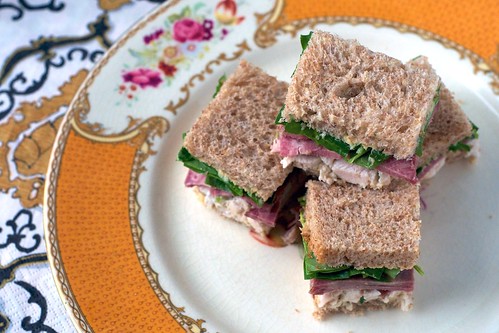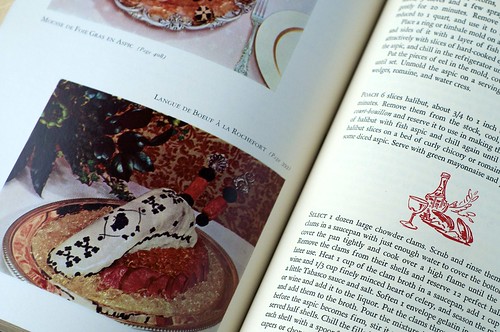Corned tongue and Queen Alexandra's Sandwiches

<
A couple years ago, my then-boss gave me a very thoughtful gift: A vintage 1958 edition of the Gourmet Cookbook, Volume II. To this day I occasionally like to sit down and flip through it, enjoy the quaint little illustrations that separate recipes and inhale the musky aroma of the quinquagenarian pages. The book is mostly text, but it is peppered throughout with occasional color plates to highlight certain recipes.
As one might expect, there's quite a lot of old-school fare in there, harkening to the deep French roots of continental cuisine so much in vogue at the time. The recipes are amusing enough as it is, but the presentation as well as the preparation is really a snapshot of retro food in the most over-the-top sense; in fact, there's an entire section dedicated to aspics. To wit: Langue de bouche à la Rochefort, beef tongue poised like a ski slope on a mound of rice, then coated in four layers chaud-froid and decorated with filigree-like slices of truffle.

Yummy.
I'm not sure this dish will grace our table anytime soon, but the fact is I rather like tongue. It's tender, it's beefy, and it's cheap. Once you get over the notion of what it is, it's really an accessible cut, and I always wonder why it's not more popular than it is.

Hence, for this month's Charcutepalooza challenge, brining, I opted to step a little to the left of the obvious corned beef and corn myself a tongue.

Having procured my tongue from Prather Ranch, I began the corning process as outlined in Charcuterie. It's simple, really, with the meat left to rest in just a brine made with vinegar and pickling spices for several days and then simmered until cooked.
After nearly a week of brining, I pulled my tongue out and laid it on the cutting board. In the process of soaking up the brine, heretofore unseen demarcations began to stand out on the skin, and now this cow-spotted muscle seemed to stick itself out at me accusingly. And I hadn't even had the chance to peel it yet. I'll leave that to the imagination.
My use for the tongue was inspired by perhaps our favorite cooking show of all time, Two Fat Ladies. It features, perhaps not surprisingly, two woman of large stature, caterers who shuttle about Britain in a motorcycle and sidecar to cook meals for various clients in often extravagant kitchens in castles, cloisters and the like.
We were infatuated with this show in the late '90s, when it originally aired. Mostly, it was entertaining to hear their chipper banter and watching Jennifer thrust her meaty, manicured talons, fully encrusted with fine jewelry, into great bowls of fats and ground meats and what have you. The show disappeared for over a decade, and has just resurfaced last year on the Cooking Channel, so do go check it out. (You know I wrote for them, right? Well you do now.)
Anyway. Tea. Right. These Queen Alexandra's Sandwiches were a staple of the Edwardian era teas (Queen Alexandra was Edward VII's wife), Clarissa, the other Fat Lady, explained. They comprise of a sturdy brown bread, mustard butter (butter, mustard and lemon juice mixed until smooth), a simple chicken salad, slices of boiled tongue and, most bourgie of all, watercress. You then of course cut the crusts off, Clarissa quips, for whatever else shall the poor people eat? I'm a bit poor myself these days, so after enjoying my own Queen Alexandra Sandwiches I went on to eat the crusts as well.
We live in an Edwardian structure, 1905 to be precise, and it tickles me to think that a hundred years nigh a tea might have happened in the very room where I was preparing and enjoying these little sandwiches. I'm relatively sure the tongue in chaud-froid has never seen the inside of these walls, however.
